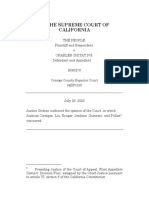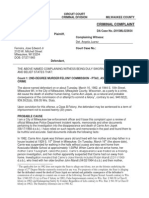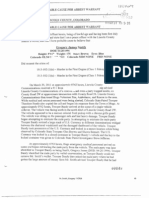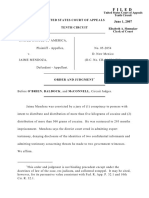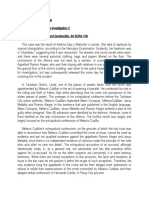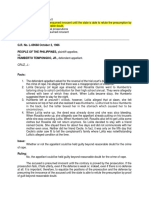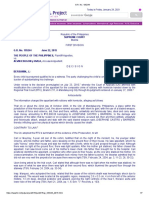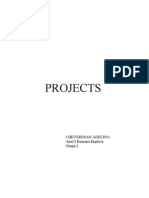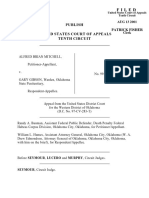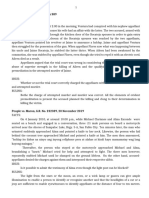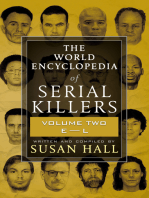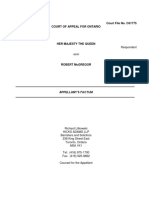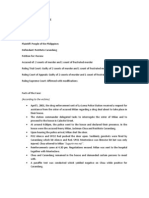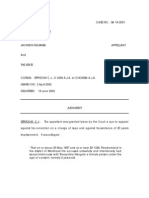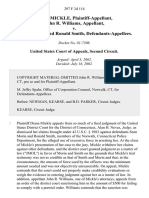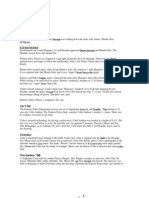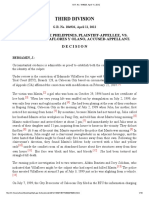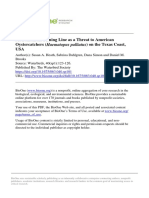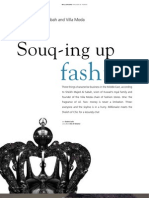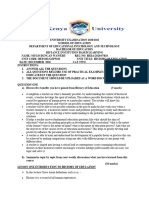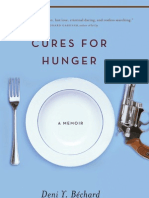Folan
Folan
Uploaded by
Tom CookeCopyright:
Available Formats
Folan
Folan
Uploaded by
Tom CookeOriginal Title
Copyright
Available Formats
Share this document
Did you find this document useful?
Is this content inappropriate?
Copyright:
Available Formats
Folan
Folan
Uploaded by
Tom CookeCopyright:
Available Formats
Judgment Approved by the court for handing down (subject to editorial corrections)
Patrick Folan - v The Crown
Supplied by Smith Bernal Reporting Ltd for Lawtel
Case No: 2002/00193/Y4 Neutral Citation No: [2003] EWCA (Crim) 908 IN THE SUPREME COURT OF JUDICATURE COURT OF APPEAL (CRIMINAL DIVISION) ON APPEAL FROM CENTRAL CRIMINAL COURT HIS HONOUR JUDGE BARKER Q.C. Royal Courts of Justice Strand, London, WC2A 2LL Date: 31 March 2003 Before : LORD JUSTICE SCOTT BAKER MR JUSTICE MITCHELL and SIR IAN KENNEDY --------------------Between : Patrick Folan - and The Crown --------------------(Transcript of the Handed Down Judgment of Smith Bernal Wordwave Limited, 190 Fleet Street London EC4A 2AG Tel No: 020 7421 4040, Fax No: 020 7831 8838 Official Shorthand Writers to the Court) --------------------Mr Courtenay Griffiths Q.C and Mr Ian Bourne for the Appellant Mr William Boyce Q.C and Miss Karmy-Jones for the Respondent --------------------Appellant Respondent
Judgment As Approved by the Court
Crown Copyright
Supplied by Smith Bernal Reporting Ltd for Lawtel
Lord Justice Scott Baker: 1. The appellant, Patrick Folan, aged 47, appeals against his conviction for murder at the Central Criminal Court on 7 December 2001. The remains of Michele Folan, his wife, were discovered during demolition work at the site of the Royal Northern Hospital near the Holloway Road in North London on 2 June 1999. She had last been seen alive on the evening of Friday 16 October 1981 in a public house about 200 yards from where her body was found. Following her disappearance a missing person inquiry was undertaken without success. The appellant was questioned but no one was arrested. In 1985 a more vigorous inquiry was conducted; the appellants house was searched and some holes were drilled in his patio, but again the inquiry was inconclusive. Unfortunately, despite extensive efforts, the police have been unable to unearth any card index, statements, documents or files relating to their earlier investigations. The sole issue on the appeal relates to the manner in which the prosecution established the appellants connection with the site where the body was found. It was the Crowns case that the appellant worked on the site at the relevant time and thus had inside knowledge of how he could dispose of the body undetected. The appellant was arrested on 3 August 1999 and interviewed under caution later the same day. He again denied he had in any way been involved in the death of his wife. He agreed he knew where the Royal Northern Hospital was but denied he had ever worked on the site. He could not remember where he was working when his wife disappeared in October 1981. He was warned by Detective Inspector Purser that one of the main lines of the police inquiry would be to investigate the scene and speak to people who were associated with the site at the time. On 24 February 2000 the police conducted a further search at the appellants home during which they discovered an Eire passport issued on 5 August 1981. The photograph on it of the appellant was later enlarged. This photograph was subsequently shown to five people in order to establish a connection between the appellant and the site. Three recognised him; two did not. The appellant complains that the evidence of the three who recognised him should not have been admitted. The evidence was obtained in breach of Code D of the Code of Practice under the Police and Criminal Evidence Act 1984 (PACE) and should have been excluded under Section 78 of that Act, not only because of this but also because, even if it did not breach any provision of the Code, it was nevertheless obtained in breach of ordinary principles of fairness. The Crowns case depended entirely on circumstantial evidence and it is necessary, before considering the appeal, to outline the case against the appellant. Background 6. There was evidence that the relationship between the appellant and his wife was a stormy one. They had two young children and lived in Holloway. The appellant admitted he punched and bruised his wife but denied specific allegations of assault against her.
2.
3.
4.
5.
Supplied by Smith Bernal Reporting Ltd for Lawtel
Micheles mother described the appellant as a jealous man. She had seen him going to hit her daughter but had never seen a blow actually land. 7. Micheles sister, Olga, had seen Michele with marks on her face and black eyes. So too had her husband, Les. Micheles half sister Tracey used to baby sit and saw bruises on her arms and black eyes. Olga said she and Les went out with the appellant and Michele in a foursome on a number of occasions. Once, during a visit to several public houses in Camden Town, the appellant was needling Michele to the point where Les had to shake him by the lapels and tell him to stop it. There was a heated argument in the cab going home. On arrival Michele showed Olga and Tracey a number of square shaped bruises and pointed to a two foot long spirit level. There was a violent argument and the police were called. Things calmed down, but after Olga and the others left they heard screaming. When Olga rushed back and looked through the letterbox she had a split second view of the appellant apparently trying to strangle Michele. Later, when they got into the house, Olga saw a kettle flex, or something like it, on the floor nearby. This evidence was, corroborated by Les. Marion Reddington was a neighbour who lived a few doors away. She was secretary of the tenants association and used to collect the subscriptions on Fridays. She gave evidence of three incidents. In March 1981 she heard screams as she was approaching the house. Michele was hanging out of a top window and the appellant was trying to push her out. He had one hand round her throat and was hitting her with the other and shouting things like Ill kill you, you cow. He desisted when Ms Reddington said she would call the police. She saw bruises on Michele a day or two later. The second incident was a few months later. The appellant was outside the front door hitting Michele with a spirit level which she described as a good two foot long. A couple of days later Michele came to see her, distressed and with a livid bruise. The third incident was on a Saturday when she heard screaming, opened her door and heard Michele screaming hes taken the baby. Hes in his pyjamas. I dont know where hes gone. The police were called. Michele Maskell met Michele by chance on a bus in the Archway Road and saw purple discoloured marks on Micheles neck. Finally there was Esther Cousins, who was a friend of Michele. Esther Cousins kept a dairy and there are a number of 1981 entries recording Michele with black eyes or bruising and marks on her neck. On 9 October 1981, that is about a week before she disappeared, she found the appellant with a meat cleaver, shaking with rage complaining he had found Michele in bed with a man. Micheles disappearance 11. Michael Norris was the stepfather of Michele. Because he had died his statement was read to the jury. He saw the appellant and Michele in the Norfolk Arms on Friday 16 October 1981. There did not appear to be any problem between them. He learned they were going on to the Crown. The next day he heard that Michele had disappeared. The appellants account was he went to the toilet in the early evening and when he returned she had gone. Mr Norriss last recollection of that evening was being given Micheles handbag by the landlady. It had been left in the Crown.
8.
9.
10.
Supplied by Smith Bernal Reporting Ltd for Lawtel
12.
Olgas evidence was that the appellant called that night about 11.30pm. He had been drinking but was not drunk. He asked if Michele was there and was told she was not and that she might have gone to the dance hall. The appellant said he had to get back to the children and if Michele did not return the next day would Olga look after the children because he had to go and price a job. He did not appear worried by Micheles disappearance. The next morning he arrived with the children. Michele had gone missing on an earlier occasion and on that occasion the appellant did report her disappearance to the police, but she returned the following day. On the morning of Saturday 17 October Bridget Daly, Micheles aunt, was shopping. Her route took her to the Holloway Road and on the corner of the hospital area she saw the appellant walking towards her. They passed the time of day but he did not mention Michele was missing. He was wearing his everyday working clothes. Micheles disappearance was not reported to the police for some time after 16 October. Mrs Norriss evidence was that this was because she assumed the appellant would have reported her missing as he had done, very promptly, on the earlier occasion. Eventually, when she discovered that he had not, she went to the police. Thereafter, because she was unhappy with the lack of progress she hired a private detective but he was no more successful. Discovery of the body
13.
14.
15.
The body was discovered by chance by a man operating a drilling rig when the site was being prepared for development in June 1999. It was beneath the floor of a single story changing room. The floor had not been laid in accordance with the building regulations. It appeared to have been a very rushed and unprofessional job. The remains of Michele lay in a shallow grave. There was a ligature around her neck and a partly torn plastic bag over her head. A wooden stick appeared to have been used to tighten the ligature. The body was clothed and jewellery was in evidence. The cause of death was probably strangulation. The place the body was found was barely 200 yards from where Michele had last been seen alive in the appellants company. The last wards of the hospital had been closed in 1992 and the site was sold for housing development. Back in 1981 remodelling work was being carried out and a firm called Greatorex and son were the main contractors. It was a big job and the site was secured at night; other specialist firms worked there. Divorce proceedings
16.
Michele obtained a legal aid certificate in June 1981. The appellant had taken their young son to Dublin without Micheles knowledge or consent, albeit he returned with him shortly thereafter. This resulted in a court order in wardship proceedings of which the appellant denies he was aware. In October 1981 she instructed solicitors, Bindmans, to start divorce proceedings. They sent a draft petition on 15 October and on the following day, which was the day she disappeared, she telephoned their office and left a message with a secretary. Nothing was heard from her thereafter.
Supplied by Smith Bernal Reporting Ltd for Lawtel
17.
When the appellants house was searched in August 1999 the police found a letter in a kitchen cupboard on top of a tin. The appellants fingerprints were on the letter, which a handwriting expert said was written by Michele. The letter was to her solicitor and said: Im very sorry for causing you so much bother but with one thing and another I cannot stay around to be the parent in my wardship. Im very sorry and also thank you for your trouble. I dont know for sure where I am going or what I am doing but I will be in touch. Thanks. Michele Folan.
18.
This letter was of importance to the Crowns case because the appellant had made no mention of it to the police, especially when coupled with the fact that he did not report his wife missing. It would have been very material when they were looking for her as a missing person. In summary the Crowns case was that there was no evidence that the motive for the killing was robbery or sex. There was no evidence that Micheles clothes were disturbed or of sexual interference and jewellery was left with the body. On the other hand, a jealous man would have much to lose by divorce and whoever left her in the shallow grave must have had knowledge of the site and the confidence to do so. There was evidence of previous significant violence on the part of the appellant towards Michele, which included causing marks on her neck. The arrival of divorce papers on the day she disappeared, plus the fact she never returned to the public house for her missing handbag and the appellants concern about losing his children (as evidenced by his trip to Dublin) all pointed to him as the killer. All this, however, was insufficient to convict the appellant without evidence connecting him with the site. The photograph
19.
20.
Following discovery at the appellants home of the passport on 24 February 2000 the photograph was enlarged. The senior investigating officer Detective Chief Inspector Headon was aware that the appellant had said when interviewed that he had not worked on the site of the Northern Hospital. The police discovered that the construction firm Greatorex and Son had carried out renovation work between June and October 1981, but they no longer had any relevant records of who had worked for them. Detective Chief Inspector Headon approached Inspector Douglas for advice because he had a wealth of experience with the metropolitan police in identification matters. His view was that showing a single photograph to the workers on the building was the only option available to the investigating officers. The purpose of showing the photograph was to locate people who knew the appellant. Apparently the two officers reached the conclusion that the purpose of the identification was not to prove or disprove involvement in the offence, but whether the appellant had worked on the site or knew anyone who had. That was not evidence of his guilt of the murder and accordingly it was neither in breach of PACE nor unfair to show the single photograph to members of the Greatorex family or former employees of the firm.
21.
Supplied by Smith Bernal Reporting Ltd for Lawtel
22.
We find the officers analysis of the situation somewhat surprising because connecting the appellant with the site was a vital plank of the Crowns case. Absent proof that he had worked there, it was highly unlikely that there would be any case to put before a jury. On the other hand proof that he had worked there was the crucial missing piece of the jigsaw. The real justification for using a photograph rather than any other means of identification was that 18 years had passed and during that time the appellants appearance had changed substantially. Between 29 February and 15 March 2000, police officers showed the enlarged photograph to five witnesses. Each was asked to sign a pro-forma statement that was read to him. It was in the following terms: I have been shown an A.4 sized photograph of a man by a police officer, who has asked me if I knew the man or worked with him between 1980 and 1982. Having studied the photograph I do/do not recognise him.
23.
24.
Three witnesses identified the appellant; two did not. None was able to name him. Each was at the same time or shortly thereafter shown a photograph of a man called Dempsey. None of the witnesses recognised him. The reason that Dempseys photograph was shown was that there was some evidence that Michele had been friendly with him shortly before her death and they might have been having an affair. Dempsey committed suicide in October 2000. Eric Greatorex was in charge of the firm between 1982 and 1985. The firm had had contracts at the Northern Hospital for something like 25 years. Much of the work was subcontracted and it was easy for the men to work in a false name. He did not recognise the photograph of the appellant. Nor did Ronald Greatorex. Paul Greatorex did recognise the appellants photograph and said that the appellant had worked for the company in the period 1980-82, but that he could not be certain on which jobs. He had seen the man walking in the Shaftesbury Road to the office. He was quiet, Irish and smartly turned out. He was either a labourer, plasterer or bricklayers assistant. He associated with a bricky called Johnny Mullen and was with the company for about six months. On one occasion he had picked him up at a house five minutes from the office. It was an old house, flat fronted and taller than the usual two-storey house. It was in a quiet side road. He thought the name of the person was Pat with a surname of either Bonner or Bond. The appellants first name is off course Patrick and the description of the house broadly fits the appellants house. Beresford Dorsett said he recognised the appellant as having worked on the job at the Royal Northern Hospital. He was with a bricky, Johnny Mullen. Gabriel Dorsett had only seen the appellant once, but recognised him. What caught his eye on the photograph was the straight hair and the features. The appellant was interviewed again but declined to answer any questions.
25.
26.
27.
28.
Supplied by Smith Bernal Reporting Ltd for Lawtel
29.
The next event of consequence was on 28 April 2000 when there was a conference with Treasury Counsel and following this three other people who had worked for Greatorex were shown a frame of twelve photographs that had been prepared and included the one of the appellant but with the Eire stamp deleted. None of them made any identification. The appellants submissions
30.
At the trial, the defence more or less abandoned the argument that Code D applied to facts of this case and relied instead on fairness albeit arguing that what was fair was informed by various provisions of the Code. Before us, however, it was submitted that Code D did apply and that its requirements had been breached. The Code deals separately with those cases in which the appellant is a known suspect and those in which he is not. The starting point in the present case is that the appellant was a known suspect, a matter that is beyond dispute. Nor is it in dispute that the purpose of showing the photograph of him was to establish whether there was any evidential link between him and the Royal Northern Hospital site. Identification by witnesses is covered by Code D: 2 of PACE. The opening words of D: 2.0 provide that a record is to be made of the description of the suspect as first given by a potential witness. The paragraph goes on to say how and when this is to be done and that the suspect or his solicitor is to be provided with a copy before proceeding to methods of identification specified in D: 2.1. These are (1) a parade; (2) a group identification; (3) a video film and (4) a confrontation. Mr Courtenay Griffiths Q.C for the appellant, who has argued the appeal with clarity and skill, makes a number of complaints about the way in which the matter was handled by the police. These can broadly be categorised as follows: i) ii) It was wrong to show one photograph to the witnesses; After the first recognition by Paul Greatorex and Gabrial Dorsett no one else should have been shown the photograph; A video parade should have been organised; The photographed should have had the reference to Eire removed; The appellants solicitor should have been told that the single photograph was to be shown; Two witnesses should not have been in the same room when they were shown the photograph.
31.
32.
iii) iv) v)
vi)
Mr Griffiths conceded that there were practical difficulties in holding an identification parade but submitted there were other options such as a video film.
Supplied by Smith Bernal Reporting Ltd for Lawtel
33.
In summary, his submissions were that the Code applied, that the identification procedures should have been in accordance with the Code but were not, that the quality of the identification evidence was poor and that the procedure in fact adopted failed to follow principles of fairness that must be followed when disputed questions of identification arise. In particular he complained about the inability of the defence to influence the procedure because they were not told what was happening. In the event, the identification evidence should not have been admitted and the conviction is unsafe. In our judgment the appellants submissions that there were breaches of the Code of Practice is built upon a false foundation. The procedures in the Code were never intended to apply to situations where it is sought to connect an individual with circumstances that occurred many years before. The appellants appearance was entirely different in 2000 from 1981 and not just because of ageing. He had, for example, grown a moustache. The Code presupposes that an identifying witness is able to give a description of the suspect. This is apparent from the opening words of D: 2.0. The police were not looking for anyone who matched a particular description. They wanted to know whether anyone could link the appellant with the place where the body was found at the time it was buried. This was a recognition case rather than an identification case. The combination of this and the passage of time made the identification procedures in the Code inappropriate. The best, and indeed only, picture of what the appellant looked like in 1981 was his passport photograph. It was this that had to form the basis of any identification. The police were faced with an unusual situation, one that was unique in their experience. What were they were to do? In our judgment it is unfortunate that they did not seek the advice of the Crown Prosecution Service or Treasury Counsel before showing the single photograph. Had they done so it is likely that the reference to Eire would have been deleted and the photograph would have been shown within a frame of twelve. Mr William Boyce Q.C., who has appeared for the Crown, submits that the frame was at best a marginal improvement over the single photograph. The appellants photograph still looks different from the others in a number of respects. We have seen a black and white copy of the frame as well as a colour copy. The black and white copy, in particular, seems to us to be a reasonable attempt to produce twelve broadly similar photographs. Even in the case of the coloured copy, the appellants photograph does not stand out as being very obviously different from the others. In the result, none of the three people who was shown the frame recognised the appellant and the question of fairness has to be considered in relation to the single photograph that was recognised by three witnesses. In the first place the judge found that the police officers had acted in good faith in relation to the photographs and that finding has not been challenged in this court. At the trial it appears to have been more or less conceded that there was no breach of the Code and the thrust of the argument was on fairness. The underlying concern about identification procedures is that the evidence of identifying witness should be untainted. The reason why it is generally preferable to show a witness a frame of at least twelve photographs rather than a single photograph is that it diminishes a risk that the defendant was suggested to the witness as the person to be identified. This is something that had been recognised by the courts for many years: see R v Dyer [1925] 2 KB 799. It should be emphasised that this was not in reality an identification case, certainly not of the fleeting glance kind. It was much more a case of recognition and what was likely to be critical from the point of view of the Crowns case was not just that the witness recognised the man but also any supplementary details that he
34.
35.
36.
Supplied by Smith Bernal Reporting Ltd for Lawtel
could provide such as in the case of Paul Greatorex and Beresford Dorsett association with Johnny Mullen, and in the case of Paul Greatorex that he was quiet, that his first name was Pat and that the description of the house from which he had collected the man and its location matched the appellants house. 37. Annex D of PACE contains a detailed procedure for the showing of photographs but it only applies to cases where the identity of the suspect is not known to the police (see Code D: 2.18). Because the appellant was a known suspect it did not therefore apply to this case. It does however spell out certain procedures that it would have been wise to follow in the present case from the general viewpoint of fairness and that should be kept in mind in any similar case in future. In other words, once as here it becomes appropriate to show photographs to a witness even where the code does not apply Annex D provides valuable guidance as to how it should be done. Obviously in the present case the requirement in Annex D: 1A that the first description of the suspect given by the witness must be recorded before he is shown the photograph was inapplicable. However, there were other provisions that it made good sense to follow. There were: D.1. D.2 Overall responsibility of an officer with a rank of at least sergeant. Photographs to be shown to one witness at a time in circumstances of privacy and no communication with other witnesses. Not less than 12 photographs of a similar type to be shown. No prompting. The photographs to be retained. A documentary record to be kept to include any comments by the witness.
38.
D.3. D.4. D.8. D.9.
There were in the present case some failures to comply with these provisions. These were: 1. A single photograph was shown to the three identifying witnesses and two who failed to identify. Paul Greatorex and Gabriel Dorsett were in the same room when they were shown the photographs. No record was kept of what was said by the three witnesses who failed to identify anyone from the frame of photographs.
2.
3.
Supplied by Smith Bernal Reporting Ltd for Lawtel
39.
As to the second of these failures, the room in which the photograph was shown to Paul Greatorex and Gabriel Dorsett was a large one. The evidence was that there was a reasonable separation between the two men and there was no indication that the presence of one in any way contaminated the identification of the other. The police were further criticised by the defence for not taking witness statements from the identifying witnesses sufficiently promptly after they had identified the photograph, thus giving the opportunity for witnesses to speak to each other before providing a written statement. Another criticism was the failure to delete the Eire stamp from the photograph. These are valid criticisms but we are quite sure the errors did not lead to any injustice. In our judgment the only failure of any significance was to show the single photograph rather than a frame containing at least twelve. The only question was whether this had such an adverse effect on the fairness of the proceedings that the judge, in the exercise of his discretion under Section 78, ought to have excluded the evidence of identification of the appellant. In our judgment the judge reached the only conclusion that he could reasonably have reached in admitting the evidence. In deciding whether to admit the evidence the judge had to apply Section 78 of PACE. Section 78 (1) provides: In any proceedings the court may refuse to allow evidence on which the prosecution proposes to rely to be given if it appears to the court that, having regard to all the circumstances, including the circumstances in which the evidence was obtained the admission of the evidence would have such an adverse effect on the fairness of the proceedings that the court ought not to admit it. The circumstances in which the evidence was obtained is therefore one, but one only, of the factors that the court is required to take into account and it is important to keep in mind that, despite the criticism levelled at them, the judge was satisfied the police acted in good faith throughout.
40.
41.
42.
There is, in our judgment, nothing to suggest that the showing of the single photograph even with the Eire stamp on it was unfair to the appellant in the circumstances of this case. There is no hint that because of being shown a single photograph rather than a frame of 12 or more any of the three witnesses erroneously recognised him. Each of the witnesses not only recognised him but was also able to give either some supplementary information about him or, in the case of Beresford Dorsett, to explain why he recognised him, namely because of his straight hair. Nor is there any evidence that recognition by one was in some way tainted by recognition of one of the others. We were referred to the words of Lord Lane C.J in R v Quinn [1990] Crim. L.R. 581, 583: The function of the judge is therefore to protect the fairness of the proceedings, and normally proceedings are fair if a jury hears all relevant evidence which either side wishes to place before it, but proceedings may become unfair if, for example, one side is allowed to advance relevant evidence which, for one reason or another, the other
43.
Supplied by Smith Bernal Reporting Ltd for Lawtel
side cannot properly challenge or meet, or where there has been an abuse of process, e.g. because evidence has been obtained in deliberate breach of procedures laid down in an official code of practice. 44. The judge ruled on the admission of the evidence on two occasions during the trial. On the first occasion he noted, correctly, that a balance had to be struck between what was fair to the prosecution and what was fair to the defence. He concluded that what the police had done was to evolve a format that was a reasonable attempt to deal with the problem, which with hindsight could have been better. Although the procedure was open to criticism it did not have such an adverse effect on the fairness of the proceeding that it ought to be excluded. We cannot fault the judges approach. The second occasion was five days later and arose because the defence had not appreciated during the earlier submissions that the police had prepared the frame of twelve photographs. The judge considered the fairness of what he described as the new situation and whether it in isolation or cumulatively affected his earlier ruling. He decided, correctly in our judgment that it did not. We would add that the three witnesses who did not pick out the appellant from the frame of twelve photographs were all in a different category from those who had recognised him. Either they were only on the site for a matter of days or they had worked on a different part of the site. Mr Griffiths makes no criticism of the summing up which was full, fair and dealt appropriately with all the issues in the case. The case against the appellant depended on circumstantial evidence, but it was a strong one. No one considering the whole of Mr Paul Greatorexs evidence could reasonably conclude that his recognition of the appellant was erroneous and although it would have been preferable for him and the other witnesses to have been shown a frame of photographs rather a single one we cannot conclude that the evidence ought not be have been admitted or that the conviction is in any way unsafe and accordingly the appeal is dismissed.
45.
46.
You might also like
- List PDFDocument19 pagesList PDFDJ RedactorNo ratings yet
- Rock County's Unsolved Murders and Missing PersonsFrom EverandRock County's Unsolved Murders and Missing PersonsRating: 5 out of 5 stars5/5 (1)
- Runes GuideDocument2 pagesRunes Guideiridal74167100% (6)
- Charles NG Supreme Court DecisionDocument181 pagesCharles NG Supreme Court DecisionEileen HollidayNo ratings yet
- Charlie Baird's Opinion and Order in The Tim Cole CaseDocument16 pagesCharlie Baird's Opinion and Order in The Tim Cole CaseCharlie BairdNo ratings yet
- Jose Ferreira Criminal ComplaintDocument4 pagesJose Ferreira Criminal ComplaintDavid Lohr100% (1)
- 116 - People Vs VillafloresDocument4 pages116 - People Vs VillafloresCharlesNo ratings yet
- Supreme Court: The Solicitor General For Plaintiff-Appellee. Adriano Pagarigan For Defendant-AppellantDocument6 pagesSupreme Court: The Solicitor General For Plaintiff-Appellee. Adriano Pagarigan For Defendant-AppellantCharlie Cagadas DechosNo ratings yet
- Gregory Smith Arrest AffidavitDocument9 pagesGregory Smith Arrest AffidavitMichael Roberts100% (1)
- United States v. Mendoza, 10th Cir. (2007)Document44 pagesUnited States v. Mendoza, 10th Cir. (2007)Scribd Government DocsNo ratings yet
- People v. NishjimaDocument15 pagesPeople v. NishjimaRoberts SamNo ratings yet
- Midterm Cases EvidenceDocument309 pagesMidterm Cases EvidenceAiai Harder - GustiloNo ratings yet
- United States v. Gladys Perez Malo, 417 F.2d 1242, 2d Cir. (1969)Document5 pagesUnited States v. Gladys Perez Malo, 417 F.2d 1242, 2d Cir. (1969)Scribd Government DocsNo ratings yet
- People v. Porferio SosingDocument8 pagesPeople v. Porferio SosingArchelaus Philo KarpusNo ratings yet
- Null 13Document69 pagesNull 13southafricanlawstudentsbarassoNo ratings yet
- LazarteDocument9 pagesLazartealnaharNo ratings yet
- FiledDocument40 pagesFiledScribd Government DocsNo ratings yet
- An Inconvenient Death: How the Establishment Covered Up the David Kelly AffairFrom EverandAn Inconvenient Death: How the Establishment Covered Up the David Kelly AffairRating: 4 out of 5 stars4/5 (10)
- United States v. Hill, 10th Cir. (2014)Document35 pagesUnited States v. Hill, 10th Cir. (2014)Scribd Government DocsNo ratings yet
- SiRT Report - Clayton MIllerDocument63 pagesSiRT Report - Clayton MIllerGlobal HalifaxNo ratings yet
- Case DigestsDocument8 pagesCase DigestshoioimtemNo ratings yet
- SCI 2 (Exam)Document3 pagesSCI 2 (Exam)Wena Mae CristobalNo ratings yet
- Criminal Law Review Case 1 ConspiracyDocument36 pagesCriminal Law Review Case 1 ConspiracyOdarbil BasogNo ratings yet
- People v. TempongkoDocument8 pagesPeople v. Tempongkored gynNo ratings yet
- Live to Tell: The Trial, Conviction, and Exoneration of Anthony WrightFrom EverandLive to Tell: The Trial, Conviction, and Exoneration of Anthony WrightNo ratings yet
- People v. Esugon G.R. No. 195244 22 June 2015Document7 pagesPeople v. Esugon G.R. No. 195244 22 June 2015Unknown userNo ratings yet
- Projects: Cheveresan Adelina Anul I Romana Engleza Grupa 2Document7 pagesProjects: Cheveresan Adelina Anul I Romana Engleza Grupa 2Adelina ErmiliaNo ratings yet
- Art 48 People Vs MartinezDocument6 pagesArt 48 People Vs MartinezRhoda VillalobosNo ratings yet
- Publish United States Court of Appeals Tenth Circuit: FiledDocument59 pagesPublish United States Court of Appeals Tenth Circuit: FiledScribd Government DocsNo ratings yet
- Commonwealth v. McCowenDocument15 pagesCommonwealth v. McCowenAENo ratings yet
- CHIMBALA V THE PEOPLE 1986-zmsc-4Document5 pagesCHIMBALA V THE PEOPLE 1986-zmsc-4Bupe NkanduNo ratings yet
- People Vs EscotoDocument9 pagesPeople Vs EscototimothymaderazoNo ratings yet
- Juiliano v. Bruce, 10th Cir. (2006)Document17 pagesJuiliano v. Bruce, 10th Cir. (2006)Scribd Government DocsNo ratings yet
- People v. FormenteraDocument3 pagesPeople v. FormenteraaratanjalaineNo ratings yet
- People V. Esugon, 759 SCRA 666 (2015) (Qualification of A Witness)Document7 pagesPeople V. Esugon, 759 SCRA 666 (2015) (Qualification of A Witness)Aisaia Jay ToralNo ratings yet
- United States of America Ex Rel. Vincent Cerullo v. Hon. Harold W. Follette, As Warden of Green Haven Prison, Stormville, New York, 416 F.2d 156, 2d Cir. (1969)Document14 pagesUnited States of America Ex Rel. Vincent Cerullo v. Hon. Harold W. Follette, As Warden of Green Haven Prison, Stormville, New York, 416 F.2d 156, 2d Cir. (1969)Scribd Government DocsNo ratings yet
- 21 People VS BaliliDocument4 pages21 People VS BaliliJudy Ann MaderazoNo ratings yet
- United States Court of Appeals: For The First CircuitDocument23 pagesUnited States Court of Appeals: For The First CircuitScribd Government DocsNo ratings yet
- Written Task English A (SL) - Critical Study - The Tell-Tale HeartDocument7 pagesWritten Task English A (SL) - Critical Study - The Tell-Tale HeartSadhaSatyaLotanNo ratings yet
- People Vs Salvador Digest PDFDocument6 pagesPeople Vs Salvador Digest PDFReham PandapatanNo ratings yet
- Cynthia Schneider Drayer, Letter To Gabe Valdez (November 23, 1996)Document8 pagesCynthia Schneider Drayer, Letter To Gabe Valdez (November 23, 1996)Ambrose AndreanoNo ratings yet
- 5 People vs. TempongkoDocument7 pages5 People vs. TempongkoEFGNo ratings yet
- VENTURADocument9 pagesVENTURABalang BregietteNo ratings yet
- Extracted From The Natasha Dostal Family SiteDocument43 pagesExtracted From The Natasha Dostal Family SiteFrank GallagherNo ratings yet
- Stoney Thompson OpinionDocument80 pagesStoney Thompson OpinionMark BickleNo ratings yet
- Robert McGregor Appeal FactumDocument60 pagesRobert McGregor Appeal FactumPeterborough ExaminerNo ratings yet
- Hollie Greig - A Survivors Battle For JusticeDocument5 pagesHollie Greig - A Survivors Battle For JusticeJohn AsprayNo ratings yet
- The O. J. Simpson Murder Case (Officially The People of The State ofDocument6 pagesThe O. J. Simpson Murder Case (Officially The People of The State ofMilica RNo ratings yet
- CRIM - Cases3 DigestDocument4 pagesCRIM - Cases3 DigestJaro Mabalot100% (1)
- Ndjimba V The StateDocument23 pagesNdjimba V The StateAndré Le RouxNo ratings yet
- Diana Mickle, John R. Williams v. Sean Morin and Ronald Smith, 297 F.3d 114, 2d Cir. (2002)Document16 pagesDiana Mickle, John R. Williams v. Sean Morin and Ronald Smith, 297 F.3d 114, 2d Cir. (2002)Scribd Government DocsNo ratings yet
- People V Phiri and Another (HJ 6 of 2011) 2012 ZMHC 75 (19 November 2012)Document52 pagesPeople V Phiri and Another (HJ 6 of 2011) 2012 ZMHC 75 (19 November 2012)pp4384112No ratings yet
- Time LineDocument6 pagesTime Linewebpros100% (1)
- People v. VillafloresDocument18 pagesPeople v. VillafloresNeil SubacNo ratings yet
- The Serial Killers - The BTK Kil - Mark SimpsonDocument47 pagesThe Serial Killers - The BTK Kil - Mark SimpsonJackNo ratings yet
- Court of Criminal Appeals of Tennessee On State of Tennessee v. Frankie E. CasteelDocument29 pagesCourt of Criminal Appeals of Tennessee On State of Tennessee v. Frankie E. CasteelNewsChannel 9 Staff100% (1)
- Monofilament Fishing Line As A Threat To American Oystercatchers (Haematopus Palliatus) On The Texas Coast, USADocument5 pagesMonofilament Fishing Line As A Threat To American Oystercatchers (Haematopus Palliatus) On The Texas Coast, USABurhan ŞahinNo ratings yet
- Math Textbook Adoption Rubric ElementaryDocument2 pagesMath Textbook Adoption Rubric ElementaryPuteri AdlinaNo ratings yet
- Semiconductors Short Notes in The Form ofDocument58 pagesSemiconductors Short Notes in The Form ofadi_risingsun0% (1)
- Ted Ammon Thought His Wife Would Kill HimDocument1 pageTed Ammon Thought His Wife Would Kill HimPatsy StoneNo ratings yet
- The Practice of Iyengar Yoga by Mid-Aged Women - An Ancient Tradition in A Modern Life PDFDocument275 pagesThe Practice of Iyengar Yoga by Mid-Aged Women - An Ancient Tradition in A Modern Life PDFyogNo ratings yet
- SheikhMajed - Villa ModaDocument9 pagesSheikhMajed - Villa ModaShalini SethNo ratings yet
- Test For Unit 10 - People & SocietyDocument3 pagesTest For Unit 10 - People & SocietyOanh Nguyen KieuNo ratings yet
- Class 8 EnglishDocument5 pagesClass 8 Englishgobindaspkota50No ratings yet
- Ben Mireku Vrs TettehDocument11 pagesBen Mireku Vrs TettehTimore Francis100% (1)
- A B C D: Choose Only One Answer For Each QuestionDocument10 pagesA B C D: Choose Only One Answer For Each QuestionAchitt AchitNo ratings yet
- Practical CriticsmDocument8 pagesPractical CriticsmDr.Kamal BhattachrayyaNo ratings yet
- MGP 002 Previous Year Question Papers by IgnouassignmentguruDocument72 pagesMGP 002 Previous Year Question Papers by IgnouassignmentguruNavneetNo ratings yet
- Employers Guide - InteractiveDocument24 pagesEmployers Guide - Interactiveapi-285398586No ratings yet
- Clubbing of IncomeDocument8 pagesClubbing of IncomeVineet Gupta100% (1)
- Standarisasi Kode Klasifikasi Diagnosa Dan Terminologi Dan Terminologi Uptd Puskesmas Cidahu Berdasarkan Icd XDocument7 pagesStandarisasi Kode Klasifikasi Diagnosa Dan Terminologi Dan Terminologi Uptd Puskesmas Cidahu Berdasarkan Icd XAna KhasanahNo ratings yet
- Astral Senses Development - Exercises For Developing One's Clairvoyant AbilitiesDocument2 pagesAstral Senses Development - Exercises For Developing One's Clairvoyant Abilitieslennypedersen162100% (2)
- Adhyatm RamayanDocument102 pagesAdhyatm RamayanGRRenga100% (2)
- The Canadian Dollar's Forward Rate Should Exhibit A DiscountDocument3 pagesThe Canadian Dollar's Forward Rate Should Exhibit A DiscountPhước NguyễnNo ratings yet
- Chp9 Sclera DiseasesDocument23 pagesChp9 Sclera DiseasesUchyIntamNo ratings yet
- Topic Date Case Title GR No Doctrine: Criminal Procedure 2EDocument2 pagesTopic Date Case Title GR No Doctrine: Criminal Procedure 2EJasenNo ratings yet
- Block Diagram of Digital ComputerDocument25 pagesBlock Diagram of Digital ComputerVikram ComputerInstituteNo ratings yet
- Finite Element Analysis - From Biomedical Applications To Industrial Developments1Document509 pagesFinite Element Analysis - From Biomedical Applications To Industrial Developments1nishantsinghbme100% (2)
- Mosaic TRD4 Tests Diagnostic PDFDocument3 pagesMosaic TRD4 Tests Diagnostic PDFAndrea Morillo Baena0% (2)
- A Crítica Da Razão Negra Achille MbembeDocument259 pagesA Crítica Da Razão Negra Achille MbembeSaul Carlos100% (3)
- Bep1101-Gep5102-History of Education Cat TwoDocument5 pagesBep1101-Gep5102-History of Education Cat Twod cNo ratings yet
- John Duvall - Don DeLillo's UnderworldDocument43 pagesJohn Duvall - Don DeLillo's UnderworldRobertoBandaNo ratings yet
- I Am A Church Member #2Document23 pagesI Am A Church Member #2Lon AlmeidaNo ratings yet
- Cures For Hunger - A Literary Memoir by Deni Y. BéchardDocument32 pagesCures For Hunger - A Literary Memoir by Deni Y. BéchardMilkweed Editions100% (1)



